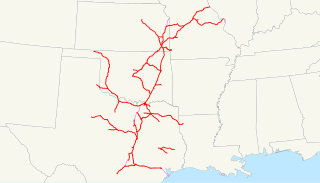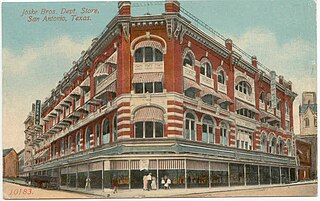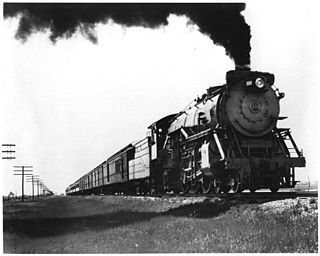Related Research Articles

Texas is a state in the South Central region of the United States. At 268,596 square miles (695,662 km2), and with more than 30 million residents in 2022, it is the second-largest U.S. state by both area and population. Texas shares borders with the states of Louisiana to the east, Arkansas to the northeast, Oklahoma to the north, New Mexico to the west, and the Mexican states of Chihuahua, Coahuila, Nuevo León, and Tamaulipas to the south and southwest; and has a coastline with the Gulf of Mexico to the southeast.

Dallas is the third largest city in Texas and the largest city in the Dallas–Fort Worth metroplex, the fourth-largest metropolitan area in the United States at 7.5 million people. It is the largest city in and seat of Dallas County with portions extending into Collin, Denton, Kaufman and Rockwall counties. With a 2020 census population of 1,304,379, it is the ninth most-populous city in the U.S. and the third-largest in Texas after Houston and San Antonio. Located in the North Texas region, the city of Dallas is the main core of the largest metropolitan area in the Southern United States and the largest inland metropolitan area in the U.S. that lacks any navigable link to the sea.

Collin County is located in the U.S. state of Texas. It is part of the Dallas-Fort Worth-Arlington metropolitan statistical area, and a small portion of the city of Dallas is in the county. At the 2020 United States census, the county's population is 1,064,465, making it the sixth-most populous county in Texas and the 43rd-largest county by population in the United States. Its county seat is McKinney.

Denton is a city in and the county seat of Denton County, Texas, United States. With a population of 139,869 as of 2020, it is the 27th-most populous city in Texas, the 197th-most populous city in the United States, and the 12th-most populous city in the Dallas–Fort Worth metroplex.

Tyler is a city in the U.S. state of Texas and the largest city and county seat of Smith County. It is also the largest city in Northeast Texas. With a 2020 census population of 105,995, Tyler was the 33rd most populous city in Texas and 299th in the United States. It is the principal city of the Greater Tyler metropolitan statistical area, which is the 198th most populous metropolitan area in the U.S. and 16th in Texas after Waco and the College Station–Bryan areas, with a population of 233,479 in 2020.

Garland is a city in the U.S. state of Texas. It is located northeast of Dallas and is a part of the Dallas–Fort Worth metroplex. It is located within Dallas County except for small portions located in Collin and Rockwall Counties. At the 2010 census, the city had a population of 226,876. In 2019, the population rose to 239,928, making it the 93rd-most populous city in the United States of America and the 12th-most populous city in Texas; by 2020, it had a population of 246,018. Garland is the third largest city in Dallas County by population and has access to downtown Dallas via public transportation including two Dart Blue Line stations and buses.

Sachse is a city in Collin and Dallas counties in the U.S. state of Texas and is part of the DFW metroplex. An eastern suburb of Dallas, the city population was 20,329, as of the 2010 census with an estimated population of 26,046 people today. Sachse is located off Texas State Highway 78 and is approximately 1 mile (1.6 km) north of the President George Bush Turnpike and Firewheel Town Center.

Fair Park is a recreational and educational complex in Dallas, Texas, United States, located immediately east of downtown. The 277-acre (112 ha) area is registered as a Dallas Landmark and National Historic Landmark; many of the buildings were constructed for the Texas Centennial Exposition in 1936.

The Missouri–Kansas–Texas Railway was a Class I railroad company in the United States, with its last headquarters in Dallas, Texas. Established in 1865 under the name Union Pacific Railway, Southern Branch, it came to serve an extensive rail network in Texas, Oklahoma, Kansas, and Missouri. In 1988, it merged with the Missouri Pacific Railroad; today, it is part of Union Pacific Railroad.

Reed Arena is a sports arena and entertainment venue located at the corner of Olsen Boulevard and Kimbrough Boulevard in College Station, Texas. This facility is used for Texas A&M University basketball games and commencement ceremonies, concerts, trade shows, family entertainment, and Texas A&M student programs, including the on-campus Aggie Muster. The building replaced the G. Rollie White Coliseum, and is named for Dr. & Mrs. Chester J. Reed, a 1947 A&M graduate whose donations made the new arena possible.
This article traces the history of Dallas, Texas,.

Joske's, founded by German immigrant Julius Joske in 1867, was a department store chain originally based in San Antonio, Texas. In December 1928, Hahn Department Stores acquired the company along with the Titche-Goettinger department store of Dallas, and three years later Hahn became part of Allied Stores. Allied was taken over by Campeau in 1986, and Campeau in turn sold the Joske's chain in 1987 to Dillard's. All Joske's stores were then quickly converted into Dillard's locations.

The Fort Worth and Denver Railway, nicknamed "the Denver Road", was a class I American railroad company that operated in the northern part of Texas from 1881 to 1982, and had a profound influence on the early settlement and economic development of the region.
This article is intended to give an overview of the history of Dallas from 1856 to 1973.
The history of Dallas, Texas, United States from 1874 to 1929 documents the city's rapid growth and emergence as a major center for transportation, trade and finance. Originally a small community built around agriculture, the convergence of several railroads made the city a strategic location for several expanding industries. During the time, Dallas prospered and grew to become the most populous city in Texas, lavish steel and masonry structures replaced timber constructions, Dallas Zoo, Southern Methodist University, and an airport were established. Conversely, the city suffered multiple setbacks with a recession from a series of failing markets and the disastrous flooding of the Trinity River in the spring of 1908.

The history of Dallas, Texas (USA) from 1930 to 1945 documents the city's emergence from the Great Depression, its economic boom after several local oil discoveries, its hosting of the Texas Centennial Exposition, and its existence during wartime.
This article is about education in Dallas, Texas (USA).

The Dallas Public Library system serves as the municipal library system of the city of Dallas, Texas (USA).

The Texas Department of Transportation (TxDOT) is a governmental agency and its purpose is to "provide safe, effective, and efficient movement of people and goods" throughout the state. Though the public face of the agency is generally associated with maintenance of the state's immense highway system, the agency is also responsible for aviation in the state and overseeing public transportation systems.
The Dallas–Fort Worth metroplex has 1.2 million African-Americans, the 2nd-largest metro population of African-Americans in Texas.
References
- ↑ Dallas Historical Society - About Archived 2007-04-09 at the Wayback Machine . Retrieved on 29 April 2007.
- ↑ Quillen • •, Alanna. "Dallas Historical Society Celebrates Centennial Anniversary with Public Viewing of Only Original Juneteenth Copy". NBC 5 Dallas-Fort Worth. Retrieved 2023-01-23.